Roosegaarde's "electronic vacuum cleaner" could solve smog problem
News: Dutch designer Daan Roosegaarde has developed an "electronic vacuum cleaner" that can remove smog from urban skies and is working with the mayor of Beijing to use the technology in a new park in the city (+ interview + movie).

The concept uses buried coils of copper to create an electrostatic field that attracts smog particles, creating a void of clean air above it.
"You can purify the air so you can breathe again," Roosegaarde told Dezeen in an exclusive interview during Dutch Design Week in Eindhoven. "It creates these holes of 50-60 metres of clean air so you can see the sun again."
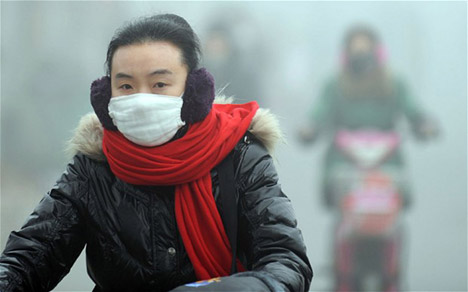
Roosegaarde's company Studio Roosegaarde has signed a memorandum of understanding with the mayor of Beijing to create a public park to showcase the technology.

The authorities in Beijing are finally admitting the huge problems caused by smog. This weekend the Beijing Environmental Monitoring Center warned children, the elderly and those with heart and breathing problems to stay indoors due to extreme levels of pollutants in the air.
Working with scientists at the University of Delft, Roosegaarde created a working prototype of the project last week. "We have a 5x5 metre room full of smog where we created a smog-free hole of one cubic metre," he said. "And now the question is to apply it in public spaces."
The buried copper coils produce a weak electrostatic field that extends into the sky above. Smog particles are drawn down towards the ground, punching a clean hole in the air and allowing the particles to be collected. The coils can be buried beneath the grass of a park and are completely safe.
"It's a similar principle to if you have a statically charged balloon that attracts your hair," Roosegaarde explained. "If you apply that to smog, to create fields of static electricity of ions, which literally attract or magnetise the smog so it drops down so you can clean it, like an electronic vacuum cleaner."
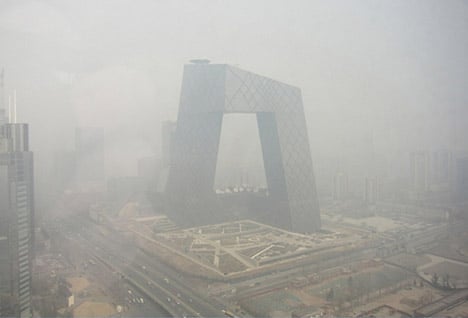
Roosegaarde had the idea for the project while staying at a hotel in Beijing and looking at OMA's CCTV building from his window. "I saw the CCTV building," he said. "I had a good day when I could see it and I had a bad day when I could not see it. On a bad day the smog is completely like a veil. You don't see anything. I thought, that's interesting, that's a design problem."
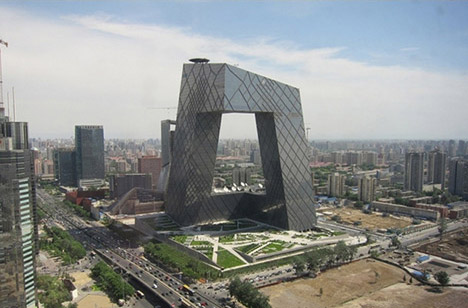
Roosegaarde's team will now spend up to 18 months developing the technology before starting work on the ground in Beijing.
Here's the text of the interview between Dezeen editor-in-chief Marcus Fairs and Daan Roosegaarde:
Marcus Fairs: Tell us about the smog project.
Daan Roosegaarde: As you may know I hop from obsession to obsession, from fashion to highways to a problem we have right now which is smog. So it's weird, because in a way we as human beings have always developed tools to enable ourselves. Wheels are an extension of our legs; glasses are an extension of our eyes; we developed cars to travel around.
But the weird thing in China, where growth is going so fast, is that these machines are striking back. They create side effects that we never thought about, which is pollution, which is smog. And Beijing is getting so incredibly worse that the American Embassy had to buy a new meter, because it was hitting the top all the time.
Marcus Fairs: How did the project come about?
Daan Roosegaarde: I was in a hotel in Beijing where I saw the CCTV building. I had a good day when I could see it and I had a bad day when I could not see it. On a bad day the smog is completely like a veil. You don't see anything. I thought, that's interesting, that's a design problem. We could use smog as a material to design with, to draw.
Marcus Fairs: How does it work?
Daan Roosegaarde: We learned a lot from the Crystal project we've done in Eindhoven, which uses static electro-magnetic fields of ions. It's a similar principle to if you have a statically charged balloon that attracts your hair.
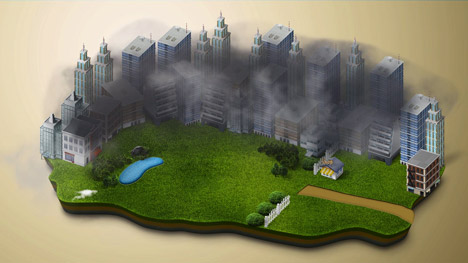
If you apply that to smog, to create fields of static electricity of ions, which literally attract or magnetise the smog so it drops down so you can clean it, like an electronic vacuum cleaner. You can purify the air so you can breathe again. And it creates these holes of 50-60 metres of clean air so you can see the sun again.
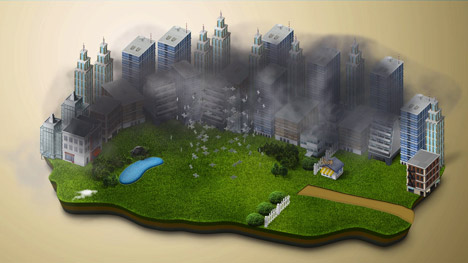
So we teamed up with the Technical University of Delft, with a smog expert, and he said the technology is possible, so we have a big indoor prototype working. And I spoke to the mayor of Beijing who, when the microphone is turned off, admits they have a big problem, and so they are investing in making it happen.
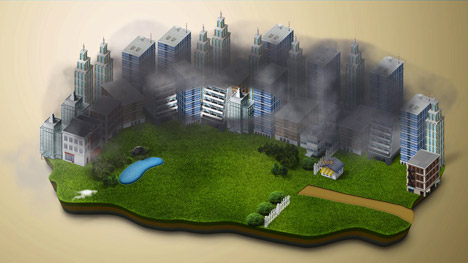
The idea is to make a park in Beijing where you will see the old world and the new world. We'll drag nature in. It's Dutch landscape design in a most radical way.
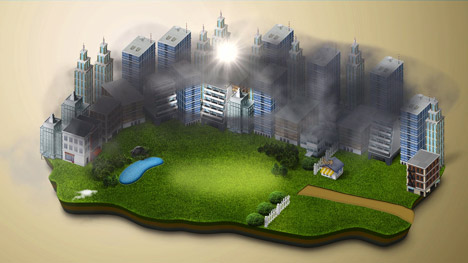
It's similar to how static electricity works, where you create a field. By electrifying particles they gravitate and fall down. It's similar to how they spray-paint metal onto surface [by a process known as vacuum metallisation, in which electrostatically charged metal particles are attracted to the surface of an object, creating a metallic surface on it].
Marcus Fairs: Could this be a solution to smog in future?
Daan Roosegaarde: It could be a first step in creating awareness of how bad it really is. Because you see the difference really clearly. Of course the real solution lies in dealing with reality in a different way; it's a human problem not a technological problem. But for sure my goal would be to apply it to parks, to public spaces which are for everyone, where people can meet and enjoy life again.
Marcus Fairs: What does the device look like?
Daan Roosegaarde: It's copper coils that we put in the ground and put grass over them so you don't see it. It sounds a bit dangerous but it's pacemaker-safe, you can walk through it, the electric field is quite low. It's an induction thing similar to how your toothbrush gets charged.
Marcus Fairs: How high can it reach?
Daan Roosegaarde: That's what we're testing now. The smog is quite low, which is good, especially in Beijing. Basically the more energy you put in it, the higher you can get. It's high voltage, low ampere, and the more power you put in the more smog you can attract.
Marcus Fairs: If you switch it on would you see the smog suddenly disappear into the ground?
Daan Roosegaarde: Yes. You would literally see it on the ground. What I would like to do is capture all that smog and then compress it. So for example you could make a smog ring of all the smog in a cubic kilometre. It would show the reality and question why we accept it.
Marcus Fairs: Have you tested it?
Daan Roosegaarde: Yes. We have a 5x5 metre room full of smog where we created a smog-free hole of one cubic metre. And that happened this week. And now the question is to apply it in public spaces.
Marcus Fairs: Is the Beijing project going to happen?
Daan Roosegaarde: Yes. We signed a memorandum of understanding to do it. They just launched [another] project, a €2.3 million project to purify air, to reduce cars, more cycling. But it's peanuts. It's not going to work.
Marcus Fairs: How much does your concept cost?
Daan Roosegaarde: The research and development is the biggest hurdle as always. It will take another 12-15 months with a good team of people to make it work, to make it safe. But we know it's possible and you know me by now: I have a scientist who says it's possible, you have me, a designer who creates the imagination and you have a client who is desperate. And now all we have to do is find the "merge" button. It's a new challenge.
Here's some text from Studio Daan Roosegaarde:
SMOG - BY DUTCH DESIGNER DAAN ROOSEGAARDE
Holes of clean air in Beijing
We have created machines to enhance ourselves. We invented the wheel and cars to liberate ourselves and travel. But now these machines are striking back, making air polluted in high-density cities like Beijing.
Dutch designer Daan Roosegaarde believes we should do more, not less and make modern cities more livable again. As a young design firm based in the Netherlands and Shanghai, he has been working on intricate designs like a sustainable dance floor which generates electricity when you dance, and smart highways which produce their own light.
Now he and his team of engineers are creating a technology to clean the air of Asian cities. By making a weak electromagnetic field (similar like static electricity that attracts your hair) the smog components in the air are pulled down to the ground where they can be easily cleaned. This creates gigantic holes of clean air in the sky. Here people can breath, and see the sun again.
This combination of high-tech and imagination is what Roosegaarde calls ‘techno-poetry’. It is time to upgrade reality.